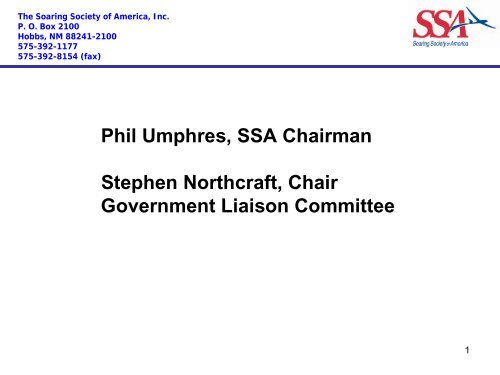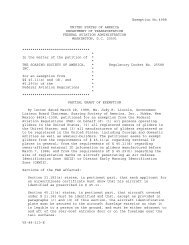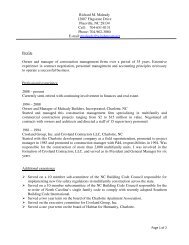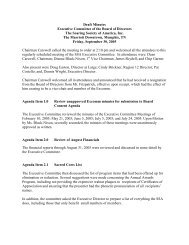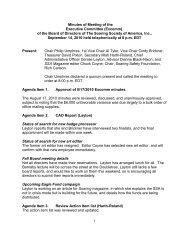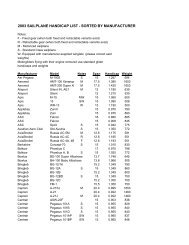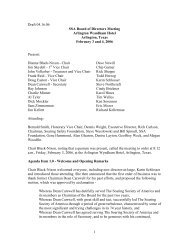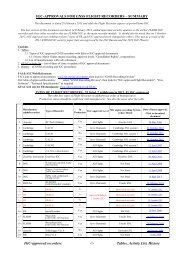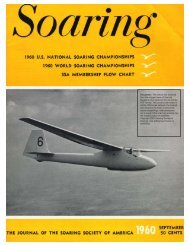glider operating area - Soaring Society of America
glider operating area - Soaring Society of America
glider operating area - Soaring Society of America
Create successful ePaper yourself
Turn your PDF publications into a flip-book with our unique Google optimized e-Paper software.
The <strong>Soaring</strong> <strong>Society</strong> <strong>of</strong> <strong>America</strong>, Inc.<br />
P. O. Box 2100<br />
Hobbs, NM 88241-2100<br />
575-392-1177<br />
575-392-8154 (fax)<br />
Phil Umphres, SSA Chairman<br />
Stephen Northcraft, Chair<br />
Government Liaison Committee<br />
1
Background<br />
The <strong>Soaring</strong> <strong>Society</strong> <strong>of</strong> <strong>America</strong> (SSA) is an organization with over<br />
11,000 members that was created in 1932 to foster and promote all<br />
phases <strong>of</strong> soaring. The <strong>Society</strong> is involved in safety programs and<br />
flight training, technological research and development, and<br />
representation to Federal agencies to preserve soaring access to<br />
airports and airspace for SSA members.<br />
For over four decades the members <strong>of</strong> the SSA have worked with<br />
various FAA entities including Flight Standards District Offices (FSDO),<br />
FAA control towers, and Flight Service Stations (FSS) to ensure the<br />
safe conduct <strong>of</strong> <strong>glider</strong> operations on publically funded airports.<br />
The SSA is now seeing the rights <strong>of</strong> our members to safely<br />
access publically funded airports compromised or denied,<br />
as a direct result <strong>of</strong> actions by local ADOs.<br />
2
What are Gliders<br />
In its simplest form, a <strong>glider</strong> is an unpowered aircraft,<br />
an airplane without a motor. While many <strong>of</strong> the same<br />
design, aerodynamic and piloting factors that apply to<br />
powered airplanes also apply to <strong>glider</strong>s, that lack <strong>of</strong> a<br />
motor changes a lot about how <strong>glider</strong>s work. Gliders<br />
are amazing and graceful machines, and are about as<br />
close as humans can get to soaring like birds.<br />
3
How are they launched al<strong>of</strong>t<br />
Gliders use three primary methods<br />
To launch:<br />
Towplane<br />
winch<br />
self-launch (motor<strong>glider</strong>)<br />
The first two methods require<br />
manpower to assist in the launch<br />
by running the wing and signaling<br />
the towplane. Staging a <strong>glider</strong> on<br />
a runway for launch requires time<br />
to place both the towplane and the<br />
<strong>glider</strong> in the proper position to launch.<br />
If the facility permits, they can be<br />
staged sequentially, as shown in the figure.<br />
Gliders staging for launch<br />
Some, but not all, motor<strong>glider</strong>s can take<strong>of</strong>f the<br />
same as power aircraft, by taxiing out to the runway.<br />
4
Typical Private Glider Operations<br />
Many <strong>glider</strong> operations are<br />
conducted on private airfields.<br />
Private operations typically<br />
set up parallel runway operations<br />
in which there is a runway for<br />
staging and launching <strong>glider</strong>s,<br />
and a separate parallel landing<br />
<strong>area</strong> for towplanes and <strong>glider</strong>s<br />
to land. This allows the <strong>glider</strong>s<br />
to be staged (see previous photo)<br />
for take<strong>of</strong>f without interfering<br />
with landing aircraft.<br />
Landing <strong>area</strong><br />
Staging and<br />
launch <strong>area</strong><br />
5
Typical Public Glider Operations<br />
Glider operations at public airports can take several forms,<br />
depending on the specifics <strong>of</strong> the airport layout.<br />
At small airports with very little traffic, <strong>glider</strong>s may operate directly <strong>of</strong>f the main<br />
runway by staging the <strong>glider</strong> and towplane at the end <strong>of</strong> the runway.<br />
At airports with multiple runways, <strong>glider</strong>s may use a different runway from<br />
other aircraft traffic to launch and recover <strong>glider</strong>s.<br />
Glider operations have been conducted from <strong>area</strong>s adjacent to runways<br />
To avoid traffic conflicts. These operations are what we want to discuss.<br />
6
Parallel Glider Operations<br />
At several public airports, Glider operations have been historically been<br />
conducted from grass (or paved) <strong>area</strong>s adjacent to runways to avoid<br />
traffic conflicts and to enhance safety. By separating the <strong>glider</strong> operation<br />
from the other aircraft using the airport, the inherent conflicts which occur<br />
when <strong>glider</strong>s are required to launch from and land on the main runway, and<br />
use the same traffic patterns, are avoided. These conflicts manifest themselves<br />
in subtle ways, including blocking the main runway while staging the <strong>glider</strong><br />
and towplane for take<strong>of</strong>f, blocking the runway again when the <strong>glider</strong><br />
lands, and flying closer and slower traffic patterns then powered aircraft using<br />
the same runway.<br />
7
FAA Guidance on Glider Operations<br />
The FAA has provided guidance for parallel operations <strong>of</strong> traditional and nontraditional<br />
(<strong>glider</strong>s, ultralights, etc.) forms <strong>of</strong> aviation. Advisory Circular 90-66A<br />
provides guidance for establishing parallel operations, essentially recommending<br />
that such operations are safer from the standpoint <strong>of</strong> mixing aircraft types<br />
with dramatically different characteristics at an airport.<br />
From 90-66A, paragraph 8;<br />
8. RECOMMENDED STANDARD TRAFFIC PATTERN.<br />
Airport owners and operators, in coordination with the FAA, are responsible for<br />
establishing traffic patterns. However, the FAA encourages airport owners and<br />
operators to establish traffic patterns as recommended in this AC.<br />
8
FAA Guidance on Glider Operations<br />
In Advisory Circular 90-66A the FAA specifically establishes guidance for<br />
Gliders, in Paragraph 9:<br />
9. OTHER TRAFFIC PATTERNS.<br />
Airport operators routinely establish local procedures for the operation <strong>of</strong><br />
Gliders, parachutists, lighter than air aircraft, helicopters, and ultralight<br />
vehicles. Appendices 2 and 3 illustrate these operations as they relate to<br />
Recommended standard traffic patterns.<br />
Glider specific guidance is included in sub-paragraph b, see next page.<br />
9
Parallel Glider Operations<br />
Paragraph 9b <strong>of</strong><br />
AC 90-66A addresses<br />
Gliders specifically.<br />
10
Parallel Glider Operations<br />
Appendix 2 illustrates the recommended<br />
traffic patterns for parallel <strong>glider</strong> operations.<br />
It also identifies a "<strong>glider</strong> <strong>operating</strong> <strong>area</strong>", and<br />
As shown in the illustration, this <strong>area</strong> could<br />
be used for both take<strong>of</strong>f and landing <strong>of</strong><br />
Gliders, and includes recommendations<br />
for <strong>glider</strong> traffic patterns.<br />
Concurrent<br />
patterns<br />
The question <strong>of</strong> establishing a "<strong>glider</strong><br />
<strong>operating</strong> <strong>area</strong>" and appropriate traffic<br />
patterns is the basis <strong>of</strong> our inquiry.<br />
Opposing<br />
patterns<br />
11
Parallel Glider Operation Issues<br />
The SSA was more than simply an interested observer when the guidance<br />
described in AC 90-66A was developed. We wanted a "blueprint" for<br />
airport owners and operators to use for establishing <strong>glider</strong> operations<br />
at public airports.<br />
The guidance was developed based on experience with <strong>glider</strong> operations<br />
at public, and private, airports over several decades for the purpose <strong>of</strong><br />
establishing a consistent way for airport operators to determine how to<br />
conduct <strong>glider</strong> operations safely.<br />
Long established parallel "<strong>glider</strong> <strong>operating</strong> <strong>area</strong>s" at several airports<br />
are now being challenging by local Airport District Offices (ADO)<br />
despite the fact that these operations may have perfect safety records,<br />
and were established with the knowledge and advice <strong>of</strong> the FAA.<br />
12
Parallel Glider Operation Issues<br />
The ADOs are using specific paragraphs <strong>of</strong> AC 150/5300 in their<br />
determination <strong>of</strong> compliance. The paragraph cited is 207 which reads:<br />
207. PARALLEL RUNWAY SEPARATION<br />
a. Standard. For simultaneous landings and take<strong>of</strong>fs using<br />
visual flight rules (VFR), the minimum separation between<br />
centerlines <strong>of</strong> parallel runways is 700 feet (214 m).<br />
However, this is for "simultaneous" operations. There is no definition<br />
if the operation is simply adjacent and not simultaneous. Typical<br />
<strong>glider</strong> <strong>operating</strong> agreements <strong>of</strong>ten preclude simultaneous operations for<br />
this very reason.<br />
Additionally, this "guidance" does not differentiate based on classes <strong>of</strong><br />
aircraft using the parallel runways.<br />
The SSA believes that this paragraph is being mis-interpreted by the ADOs<br />
to preclude safe <strong>glider</strong> operations by assuming that any adjacent<br />
13<br />
<strong>glider</strong> operation is "simultaneous".
Parallel Glider Operation Examples<br />
In the past year one <strong>glider</strong> operation has been closed as a result <strong>of</strong><br />
ADO concerns. A second been threatened with closure as a result<br />
<strong>of</strong> the local ADO raising concerns. A third has seen the ADO renege<br />
on an agreement resulting in a significant compromising <strong>of</strong> the safety<br />
<strong>of</strong> the <strong>glider</strong> operation, and a 4th was denied the establishment <strong>of</strong> a<br />
parallel "<strong>glider</strong> <strong>operating</strong> <strong>area</strong>" that was requested. A fifth <strong>glider</strong><br />
operation in which a parallel operation was closed several years ago<br />
is now threatened by ADO action for other reasons.<br />
The operations:<br />
Hemet, CA<br />
Arlington, WA<br />
Ephrata, WA<br />
Midlothian, TX<br />
Frederic, MD<br />
<strong>glider</strong> operation was closed, letter to <strong>glider</strong><br />
representative cited the parallel operations<br />
Glider operation being reviewed, ADO sent<br />
letter stating that the operation was "unsafe"<br />
ADO reneged on agreement to allow airport<br />
to declare the parallel runway "<strong>glider</strong> only"<br />
after 2 years <strong>of</strong> operations<br />
parallel <strong>glider</strong> operation denied.<br />
parallel operation closed, ADO claims that<br />
the <strong>glider</strong> lease is not "fair market value"<br />
14
Hemet, CA Example<br />
Background:<br />
Status:<br />
over 40 years <strong>of</strong> <strong>glider</strong> operations at the Hemet, CA<br />
airport (HMT). Parallel runway operation established<br />
and indicated in the Airport Facility Directory (AFD).<br />
Parallel Glider operation closed October, 2009. Currently<br />
no <strong>glider</strong> activity at airport. Glider pilots considered<br />
change from parallel operation to main runway "unsafe".<br />
In letter dated August 18, 2009 to <strong>glider</strong> representatives,<br />
the airport specifically cited the parallel operation:<br />
Other claims made in that letter are either contested by the<br />
<strong>glider</strong> community or were not mentioned by the airport prior<br />
to the release <strong>of</strong> that letter.<br />
15
Hemet, CA Example<br />
Parallel <strong>glider</strong> operation<br />
described in AFD, runway<br />
shown. Now closed.<br />
350 foot separation between<br />
Main runway (5-23) and<br />
Glider runway (4-22) deemed<br />
By ADO to not be in<br />
compliance with AC 150/5300<br />
despite 40 year history <strong>of</strong><br />
operations.<br />
16
Arlington, WA Example<br />
Background:<br />
Status:<br />
over 20 years <strong>of</strong> <strong>glider</strong> operations at the Arlington, WA<br />
airport (AWO). Parallel runway operation established<br />
in the grass <strong>area</strong> parallel to the main runway (16-34)<br />
approximately 350 feet centerline to centerline. Two<br />
cross taxiways divide the grass <strong>area</strong> into 3 distinct<br />
sections. The <strong>glider</strong>s are launched from the center <strong>area</strong><br />
and land on the end <strong>area</strong>, depending on the wind<br />
direction. Patterns are opposite from the power traffic.<br />
ADO sent letter to airport declaring <strong>glider</strong> operation "unsafe"<br />
and later suggested moving the operation to the west to meet<br />
the 700 ft issue; result would have been a runway 1500 ft AGL ceilings at current<br />
location. Still in discussion phase.<br />
17
Arlington, WA Example<br />
Ultralight<br />
operation<br />
Suggested<br />
New <strong>area</strong><br />
Current <strong>glider</strong> staging and take<strong>of</strong>f <strong>area</strong><br />
Current <strong>glider</strong> landing <strong>area</strong>s<br />
Other issues include "pedestrians" and staging. There has been discussion<br />
whether or not personnel can be allowed to "maneuver" <strong>glider</strong>s from the<br />
tiedown <strong>area</strong> to the staging <strong>area</strong> for take<strong>of</strong>f.<br />
18
Ephrata, WA Example<br />
Background:<br />
Status:<br />
<strong>glider</strong> operation established on the ramp in 1971 with<br />
concurrence <strong>of</strong> local FSS and FSDO. Consisted <strong>of</strong> parallel<br />
<strong>glider</strong> operation on ramp with take<strong>of</strong>f <strong>area</strong> and adjacent<br />
landing <strong>area</strong> (not simultaneous). In 2003, ADO declared<br />
<strong>glider</strong> operation "not in compliance" (
Ephrata, WA Example<br />
BEFORE<br />
Original landing <strong>area</strong><br />
AFTER<br />
Signs located on<br />
either side <strong>of</strong> OFA<br />
Original take<strong>of</strong>f/staging <strong>area</strong><br />
No accident history<br />
For over 30 years<br />
New ramp<br />
runway<br />
Gliders must stage outside yellow lines<br />
and launch diagonally onto runway<br />
20
Ephrata, WA Example<br />
Airport has been informed that<br />
dedicating the ramp runway (4-22)<br />
to "<strong>glider</strong> use only" is not in compliance<br />
and that the runway must be available<br />
to all users.<br />
ADO informed by airport that Order<br />
5190.6B , Paragraph 14.3 specifically<br />
allows for:<br />
"A prohibition or limit may be based on<br />
safety or on a conflict between classes<br />
or types <strong>of</strong> operations."<br />
And:<br />
that as long as an equivalent capability<br />
for other aircraft is provided, the<br />
prohibition is acceptable:<br />
"..to the extent that they are consistent<br />
With the sponsor's obligations…"<br />
21
Midlothian, TX Example<br />
Background:<br />
Status:<br />
SSA received a request from a member to assist in<br />
establishing a parallel <strong>glider</strong> operation at the Midlothian, TX<br />
airport (JWY). Correspondence indicates that Airport is using<br />
guidance in AC 150/5300 as a basis for restricting the <strong>glider</strong><br />
operation to main runway and has been consulting with FAA<br />
entities to "prevent <strong>glider</strong> operations on grass". No history <strong>of</strong><br />
accidents or incidents related to <strong>glider</strong> operations.<br />
This appears to be an example <strong>of</strong> an airport trying to<br />
"upscale" and the <strong>glider</strong> operation does not fit with their<br />
long term plans.<br />
As an aside, the <strong>glider</strong> operation is run by an FAA DE and<br />
has the FAA's national contract for initial and recurrent<br />
<strong>glider</strong> training <strong>of</strong> Aviation Safety Inspectors.<br />
22
Midlothian, TX Example<br />
Insufficient clearance available<br />
for "parallel operations"<br />
23
Frederick, MD Example<br />
Background:<br />
Status:<br />
In 1989 FDK used $5M in AIP money to pave runway<br />
12-30 and establish a "<strong>glider</strong> <strong>operating</strong> <strong>area</strong>" (GOA) adjacent<br />
to it. The GOA was approved by the FAA. Concurrent with<br />
the establishment <strong>of</strong> the GOA, the local <strong>glider</strong> club signed a<br />
20 years lease for property adjacent to the GOA and<br />
developed hangars and a clubhouse; the facility to revert to<br />
FDK ownership on expiration <strong>of</strong> lease in 2012. In 2003, the<br />
local ADO claimed that the GOA was not documented and<br />
informed FDK that the GOA had to cease. More recently, the<br />
ADO informed FDK that the lease signed by the <strong>glider</strong> club<br />
was not at "fair market value", and that they would withhold<br />
further AIP funding from FDK until the leased was<br />
changed.<br />
The <strong>glider</strong> operation is currently being conducted from runway<br />
12-30. FDK has not abrogated the <strong>glider</strong> club lease and the<br />
ADO is withholding AIP funding ($13M).<br />
24
Frederick, MD Example<br />
The <strong>glider</strong> hangar will revert to FDK<br />
ownership with the expiration <strong>of</strong> the<br />
<strong>glider</strong> club lease in 2012<br />
Glider runway<br />
(closed)<br />
25
Summary<br />
Local ADOs have required changes to several long<br />
standing <strong>glider</strong> operations despite:<br />
No record <strong>of</strong> safety issues<br />
FAA concurrence with original operational design<br />
(consistent with AC 90-66A)<br />
No coordination with FSDO (or even over their objection)<br />
The ADO for Frederick, MD is questioning the "fair market value" <strong>of</strong> a lease<br />
signed 18 years ago.<br />
In some cases the ADO appears to be a willing partner in driving the <strong>glider</strong>s <strong>of</strong>f<br />
non-commercial public airports.<br />
ADOs are withholding, or threatening to withhold, funding from airports based<br />
on interpretation <strong>of</strong> standards that is not consistent with FSDO interpretation<br />
26
Recommendations<br />
The SSA recommends the following actions to address<br />
the issues we have noted:<br />
1) AC 150/5300 paragraph 207 be revised to clarify that<br />
"non simultaneous" parallel VFR operations closer than the<br />
700 foot separation quoted are acceptable; consistent with<br />
AC 90-66A.<br />
and<br />
2) The ADOs cease the practice <strong>of</strong> holding airport funding<br />
hostage to strict adherence to AC 150/5300; particularly in<br />
cases where the FSDO and the ADO do not agree on operations<br />
(airports can not move existing runways, for example)<br />
and<br />
3) The ADOs coordinate with, and defer to the recommendations<br />
<strong>of</strong>, the FSDOs regarding operations and safety <strong>of</strong> operations<br />
27


